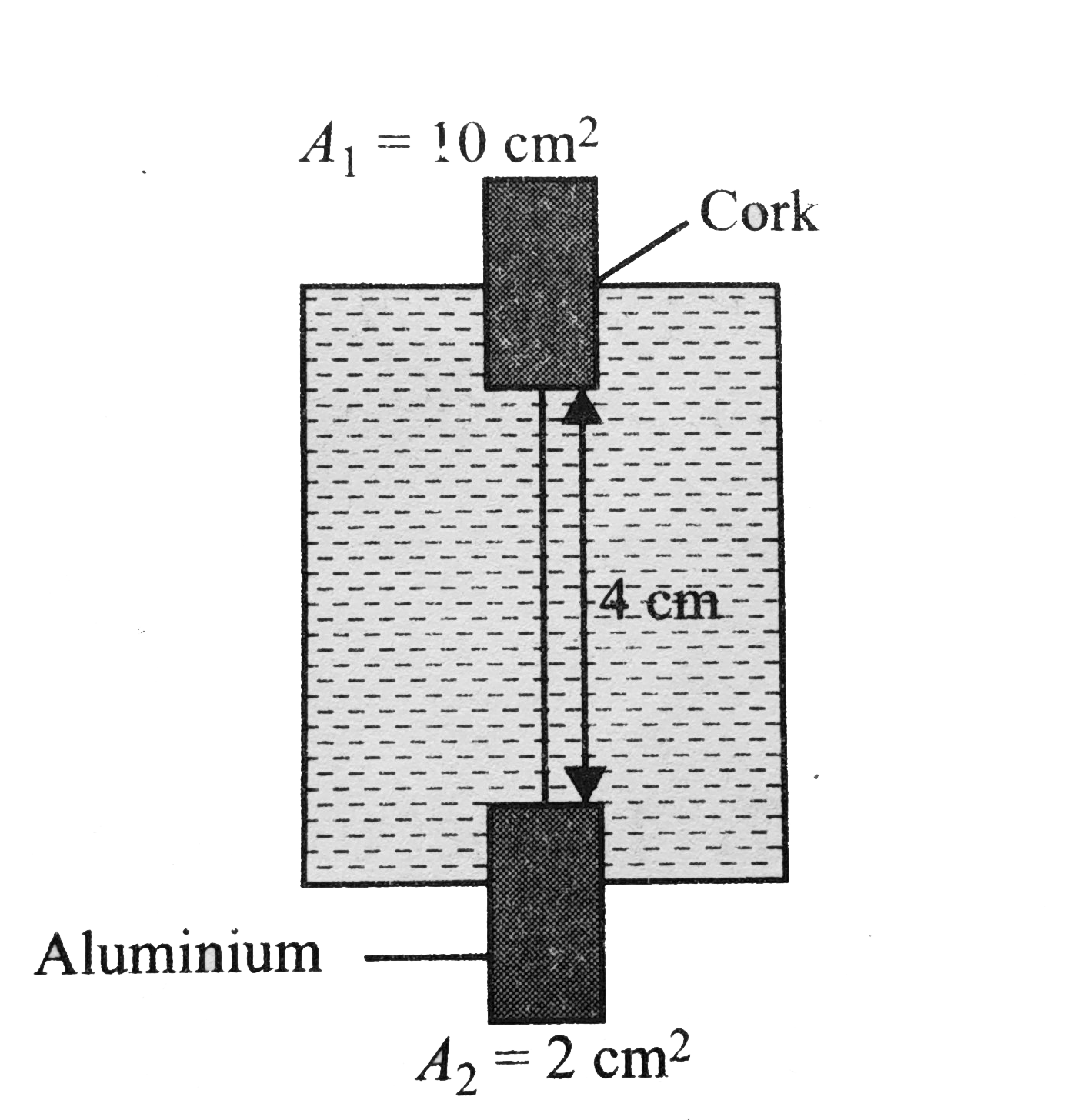A cylindrical object of cork of mass 15g and cross-sectional area A1=10cm2 floats in a pan of water as shown in the figure. An aluminum, cylinder of mass 25g and cross-sectional area A2=2cm2 is attached 4cm below the cork and slides through a watertight frictionless hole in the bottom of the pan. Take density of the cork, ρ=0.2g/cm3,ρaluminium=2.7g/cm3,g=10m/s2. Based on the above information, answer the following questions.

The tension in the string joining the cork and aluminium cylinder is
2N
1N
0.45N
0.6N
The correct Answer is:C
Let x cm be the length of cork cylinder inside the water and T be the tension in the string.
The free body diagram of the two cylinders are as shown in the following figures.

Here m1=15g,m2=25g,h=4cm,vin=A1xcm3
For cork cylinder T+m1g=Vinρg
For aluminium cylinder
T+ρ0A2=m2g(p0+ρgx+ρgh)A2
⇒x=6cm
T=0.45N
Topper's Solved these Questions
- FLUID MECHANICSBook:CENGAGE PHYSICSChapter:FLUID MECHANICSExercise:True/False
Explore 1 Video
- FLUID MECHANICSBook:CENGAGE PHYSICSChapter:FLUID MECHANICSExercise:SCQ_TYPE
Explore 13 Videos
- FLUID MECHANICSBook:CENGAGE PHYSICSChapter:FLUID MECHANICSExercise:Assertion-Reasoning
Explore 8 Videos
- DIMENSIONS & MEASUREMENTBook:CENGAGE PHYSICSChapter:DIMENSIONS & MEASUREMENTExercise:Integer
Explore 2 Videos
- GRAVITATIONBook:CENGAGE PHYSICSChapter:GRAVITATIONExercise:INTEGER_TYPE
Explore 1 Video
Similar Questions
A barometer made of very narrow tuve (see fig) is placed at normal temperature and pressure. The coefficient of volume expansion of mercury is 0.00018perC∘ and that of the tube is negligible. The temperature of mercury in the barometer is now raised by 1∘C, but the temperature of the atmosphere does not raised by 1∘C, but the temperature of the atmosphere does not change. Then the mercury height in the tube remains unchanged.

View SolutionA metal ball immersed in alcohol weights W1 at 0∘C and W2 at 50∘C. The coefficient of expansion of cubical the metal is less than that of the alcohol. Assuming that the density of the metal is large compared to that of alcohol, it can be shown that
View SolutionAssertion: Pascal law is the working principle of hydraulic lift.
Reason: Pressure =thrustarea
View SolutionTo find the distance d over which a signal can be seen clearly in foggy conditions, a railways-engineer uses dimensions and assumes that the distance depends on the mass density ρ of the fog, intensity (power/area) S of the light from the signal and its frequency f. the engineer finds that d is proportional to S1/n. the value of n is
View SolutionGravitational acceleration on the surface of the planet is √611g. where g is the gravitational acceleration on the surface of the earth. The average mass density of the planet is 23 times that of the earth. If the escape speed on the surface of the earth is taken to be 11kms−1 the escape speed on the surface of the planet in kms−1 will be
View SolutionA cylindrical object of cork of mass 15g and cross-sectional area A1=10cm2 floats in a pan of water as shown in the figure. An aluminum, cylinder of mass 25g and cross-sectional area A2=2cm2 is attached 4cm below the cork and slides through a watertight frictionless hole in the bottom of the pan. Take density of the cork, ρ=0.2g/cm3,ρaluminium=2.7g/cm3,g=10m/s2. Based on the above information, answer the following questions.

The length of the cork cylinder inside the water in equilibrium is
View SolutionA tube 1 cm^2 in cross = section is attached to the top of a vessel 1 cm high and of cross - section 100 cm^2 Water is poured into the system filling it to a depth of 100 cm above the bottom of the vessel as shown in fig. Take g = ms^I(-2) Now.
View SolutionA cork of mass 10 g is floating on water. The net force acting on the cork is
View SolutionA cylindrical object of the area of cross section 5 cm^(2) floats (lateral side vertical) in water filled in a cylindrical container of the area of cross section 15 cm^(2) . When the object is placed in water the level of the water in the container rises by 2 cm and the density of the object?
View SolutionThe cross-sectional area of a cylinder is 4cm^(2) . It floats vertically in water and alcohol with 8 cm and 10 cm immersed respectively. Determine the mass of the cylinder and the density of alcohol.
View SolutionA piece of cork of density 0.25g*cm^(-3) , attached to a metal piece of mass 10 g and of density 5g*cm^(-3) , is found to float completely immersed in water. Determine the volume of the piece of cork.
View SolutionA piece of cork (density 0.8g*cm^(-3) ) is placed at the bottom of water. If now the cork is released, then prove that it will rise upwards with an acceleration of g/4 .
View SolutionA cylindrical wooden cork of mass 250 g and cross sectional area 10 cm^(2) is floating into a beaker filled with water, with an extra weight of 30 g attached to its bottom, as shown in the adjoining figure. If the cork Performs, S.H.M., determine its frequency. take, Specific gravity of wood = 0.30 g = 9.8 m//s^(2)
View SolutionA cork of mass 10 g is floating on water. The net force acting on the cork is
View SolutionA cork has a volume 25 cm^3 . The density of cork is 0.25 g cm^(-3) . Find the mass of the cork.
View Solution

